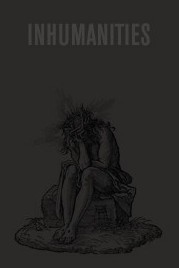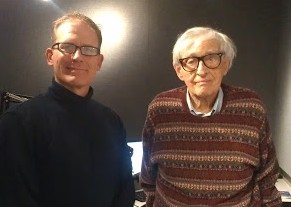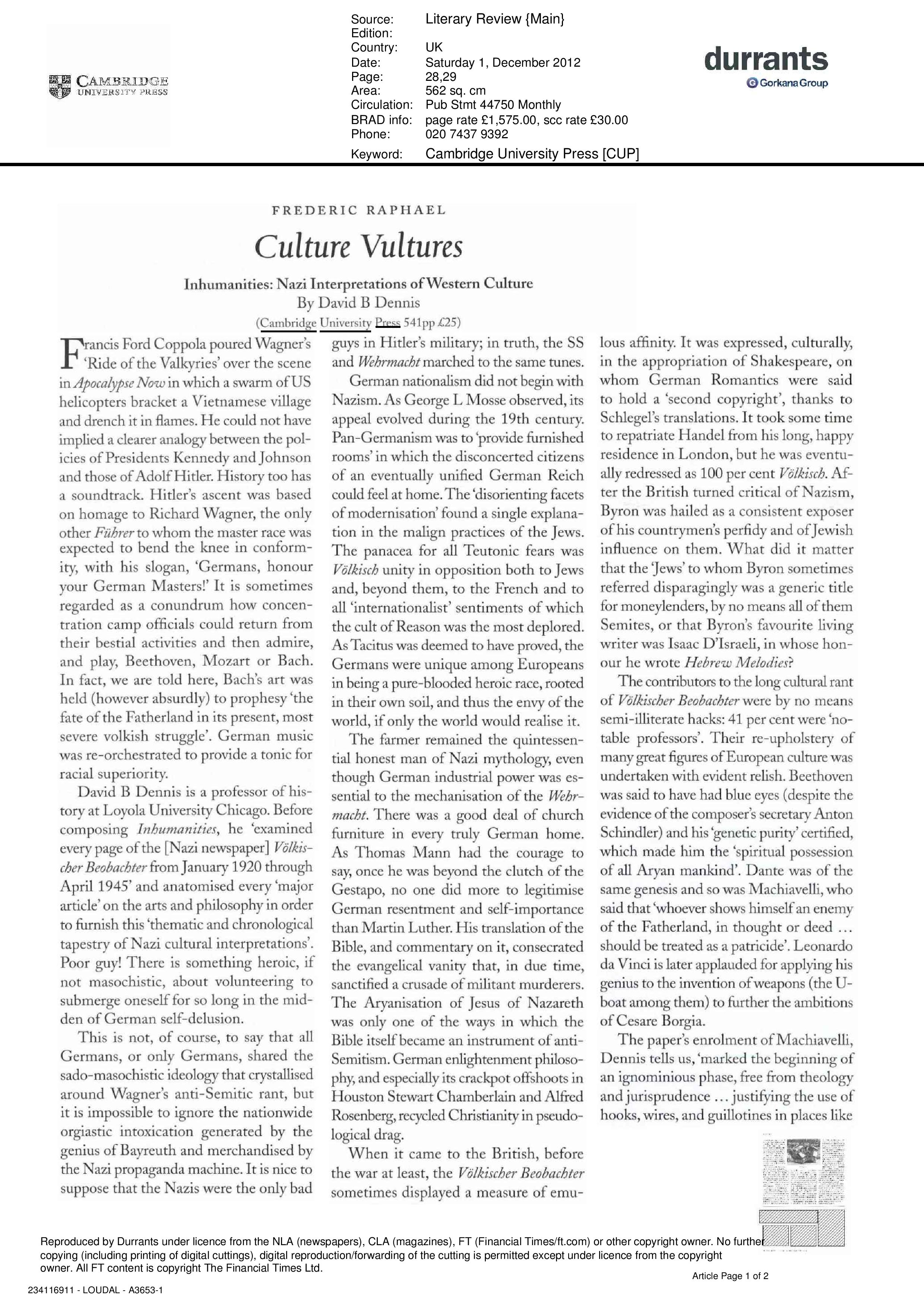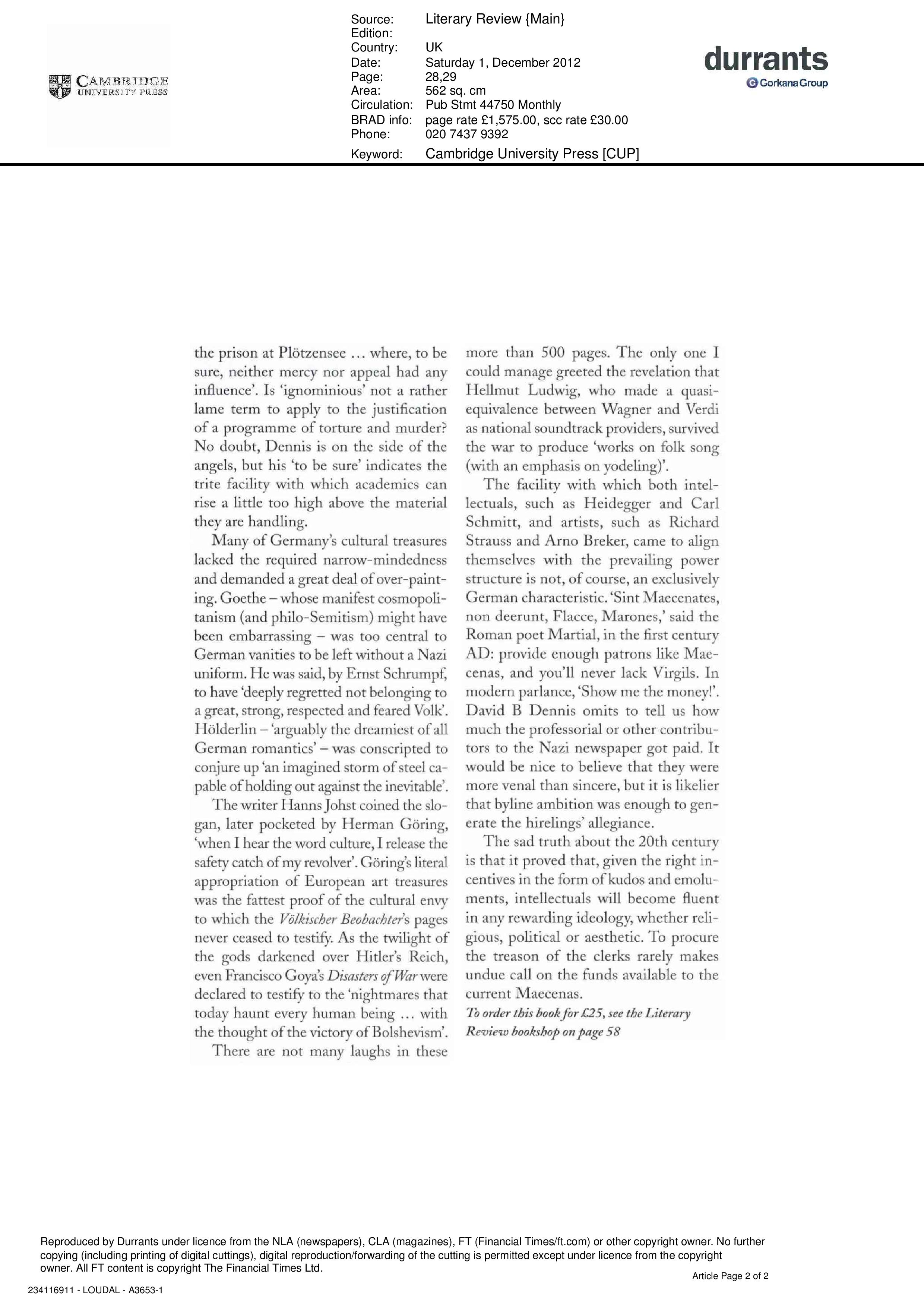 Listen to a conversation about the book which occurred on Extension 720 with Milt Rosenberg, Radio 720 WGN, on Wednesday, December 19, 10 pm to midnight. This was the last interview that Milt Rosenberg did on this show which had run for 39 years! It was an honor to be included on this important American media institution.
Listen to a conversation about the book which occurred on Extension 720 with Milt Rosenberg, Radio 720 WGN, on Wednesday, December 19, 10 pm to midnight. This was the last interview that Milt Rosenberg did on this show which had run for 39 years! It was an honor to be included on this important American media institution.
Monthly Archives: December 2012
Review of Inhumanities in Maclean’s (Canada)

Most people are aware of what the Nazis hated: modern Western culture in general, especially ideals of religious and racial equality, and Jews, seen as the bacillus most responsible for spreading those toxic concepts, in particular. Less well understood is what the Hitlerites admired. The Nazis, or at least the true believers among them, did not see themselves as the murderous nihilists they were, but as defenders of “true”—meaning mystically transmitted by race and blood—Western art and culture. They didn’t just have their cultural enemies—Sigmund Freud, say, who combined Jewish ancestry with repulsive ideas—but their cultural heroes, too, most notably Hitler’s idol, anti-Semitic composer Richard Wagner.
Dennis, a historian at Loyola University in Chicago, examined two decades of cultural war as waged by Nazi theorists in their party’s official newspaper, the Völkischer Beobachter. A lot of what he found, were it the product of basement-dwelling Internet cranks rather than men about to unleash a tide of unparalleled barbarism, would be comic.
Take the case of Beethoven, whom—to Hitler’s disgust—the vast majority of Germans revered far more than Wagner. He was German, all right, but his father was a severe alcoholic and, according to Nazi social policy, should have been sterilized long before he begat Ludwig. Not to worry, Nazi Beethoven devotees, wrote Bonn professor Ludwig Schiedermair. If Johann van Beethoven “gladly drank wine and punch and once in a while offered girls little kisses in jest,” it was only because he was from the alcohol-loving Rhineland, where they understood that sort of zesty living. Foreigners, annoyingly enough, had to be admitted to the pantheon if enough Germans admired them. It helped, of course, if there was any record of anti-Semitic remarks on an outsider’s part: The Merchant of Venice, far more thanHamlet, brought Shakespeare into the fold.
In the end, though, what Dennis found was not comic at all: a long and depressingly successful campaign to convince Germans the Third Reich was the purification of Western civilization, not its antithesis.
Review of Inhumanities in the Literary Review (UK)
Review of Inhumanities in Toronto Globe and Mail
Review of Inhumanities in Toronto Globe and Mail
CULTURE
Interpreting art through a Nazi lens
ROBERT EVERETT-GREEN
The Globe and Mail
Published Last updated
Nazism styled itself as a movement of the future, but was also deeply interested in forging a usable past. In the pages of the party’s Volkischer Beobachter (VB), the main daily newspaper during Hitler’s regime, Nazi arts critics and journalists schooled the masses in the Reich’s view of its own cultural prehistory. In the arts, the party favoured “Volkish” directness over refinement, and gut-level Romanticism over the supposedly more cerebral arts of the Enlightenment. But an artist’s actual work and ideas were no impediment, if his presence was required in the Reich’s pantheon. American historian David B. Dennis analyzed every issue of the VB’s 25 years of Nazi journalism, and distilled the results into his new book, Inhumanities: Nazi Interpretations of Western Culture (Cambridge UP). Here are five examples of the contortions VB writers performed to make sure their artists’ club had all the right members.
In Mein Kampf, Hitler said that “all human culture” was produced by Aryans. To fit non-German titans such as Michelangelo into this statement, the Italian painter and sculptor had to be repatriated to a vague spiritual territory called the “Nordic West.” His actual ethnic background was no help, so the VB looked at his works and described them with what Dennis calls “the language of power, competition, and overcoming – particularly overcoming the rational Hellenic tradition by imposing his strong passions.” In a word, says Dennis, Michelangelo was a Renaissance Ubermensch, whose later works turned away from classical models toward what the VB called a more “expressionistic esthetic.” Contemporary German expressionists such as Emil Nolde, meanwhile, were being denounced as decadent.
Mozart had to be in the Nazi pantheon, but not as a cosmopolitan Classical composer who was born in Austria and wrote Italian operas. VB writers searched his Swabian and Bavarian bloodlines and claimed to find ethnic roots for his “decidedly German style.” They declared him a German patriot and “heroic-demonic fighter” who was determined to replace the alien Rococo style of his day with a Romantic, “genuinely German opera.” Mozart’s debt to Italian tradition was discharged by saying he somehow “violently broke from Italian influence” while writing The Marriage of Figaro and Don Giovanni. His letters from Paris were selectively mined to prove that he despised the French and their arts, and his apparently frivolous Cosi fan tutte was blamed on his Jewish librettist, Lorenzo da Ponte. The VB celebrated The Magic Flute as “the first truly German opera,” and especially adored the Volkish tunes and character of Papageno. The opera’s Masonic symbolism were again blamed on the librettist.
For the Nazis, says Dennis, Heinrich Heine was “the most irritating figure in German cultural history.” Most cultured Germans saw his poetry as central to the Romantic tradition, and his verses were set to music by A-list composers such as Schubert, Schumann and Hugo Wolf. But Heine was also a Jew, so he had to be thrown out of the canon somehow. The VB obliged by abusing him as a phony, a cynic and a plagiarist. They said he stole his best ideas from Byron, had himself baptised only to help his career, and concealed a Jewish sneer behind every beautiful poetic surface. The fact that he knew Karl Marx in Paris and predicted revolution was a bonus: the VB branded him a “communist agitator” and a “French-Jewish spy.”
Gustav Mahler, the last great Germanic symphonist, had to be denounced by the VB because he was born a Jew. Its case against him was typical: He was a decadent imitator who “appropriated the means and techniques” of real German music without the German spirit necessary to make those things meaningful. All his work was thus a caricature of the real thing. The VB also explored Mahler’s psyche, diagnosing him as “fundamentally neurotic,” dominated by a selfish ego and suffering from an incurable case of “psychopathia musikalis.” One wonders what Freud, whose books were burned by the Nazis, would have said of their efforts at posthumous psychoanalysis.
In November 1944, with the Nazi empire shrinking and battle raging inside Germany, the VB pointed to an unexpected source for a “level-headed perspective on the experience of war.” Francisco Goya’s paintings of scenes from the 1808 Spanish uprising against Napoleon were offered as inspiring images of passionate armed struggle against foreign invaders. Never mind that Goya was court painter to both indigenous and Bonapartist regimes in Spain, and made his retrospective paintings of the 1808 revolt mainly to prove his loyalty to the restored Spanish crown. His Disasters of War series, said the VB, showed what horrors that would result if “Bolshevism and its accomplices” won in Europe. To forestall any idea that Goya was disgusted by slaughter – the usual reading of his Disasters series – the VB insisted that “war was the father of all things for Goya.” Within six months, war had proven to be the end of all things for the Nazis.
Amazon Customer Review of Inhumanities
 5.0 out of 5 stars The twisted mind of the Nazis November 30, 2012
5.0 out of 5 stars The twisted mind of the Nazis November 30, 2012
At the center of this opus stand the infamous Nazi newspaper” Volkischer Beobachter”, hich served as a major propaganda tool of the Nazis. Professor Dennis has invested a colossal effort in examining every page of the newspaper from 1920 to 1945 and has also gathered 1600 articles which dealt with literature, philosophy, painting, sculpture, architecture and music. These topics were used as tools in the Nazi interpretation, or, one may say, cultural intepretation and correlation with the party’s doctrines with the Western tradition of humanities or Kultur.In a way, this book is about Nazi progaganda, but it is more than that; it is a very broad analysis of how the Nazis have used the many facets of humanities in order to totally alter and adapt the original meaning of the various artistic modes so that they fit into the Nazi mind and ideology. The readers of the newspaper were given ample samples which demonstrated and meant to convince them that the German culture was the best and the most noble one, unsurpassed by any other nation’s cultural achievements. Thus readers could make sense of their world and the ongoing events surrounding them.
The book is divided into five parts and each is about another aspect. Part One is a chronological survey of the Wetern tradition a la Volkischer Beobachter. Part Two, called” Blind to the Light” is about how the Nazi newspaper addressed the Western rationalist tradition from the ancients to the French Revolution. The highlight was in the romantic peroiod. The onslaught on the enlightnment was in full vigor and the French philosophers were suffering from a “disease”. Ditto for Heine who was only serving the cause of the Jews, albeit his conversion to Christanity.In another part, the newspaper eulogized the volkich thinkers of the nineteenth century, attacking everything which was not German or Aryan. One example was the targeting of the modern styles in music or other arts, which were considered perverted and engaged in absurd modernist styles. This trend went on in the paper’s attacks against Weimar era culture and politics. Here the paper was busy in unleashing a venomous attack on Jews and Judaism showing how the cultural-historical figures were ignored or dishonored by leftist or Jewish controlled authorities of the period. Bertold Brecht, Alfred Doblin and the Mann brothers were among the November criminals and “asphalt literati”. In addition, Schoenberg and Weill were not spared because they represented the rotten modernist ideals and ideas.
The last part covers a few acceptable alternatives to the Weimar decadence. There was a need for a “Nazi Renaissance”. Luther’s legacy, for example, had been ignored and with it his anti-Jewish component because of a “liberal” or” “objective” form of Protestantism and, according to the Nazis, the Jewish Question” of Luther was not considered because of the Weimar criminals. Beethoven was to be associated with the very identity of the Nazi movement; the composer’s Ninth Symphony marked a significant and a “superior Germany, while Schiller’s and Beethoven’s high ideal of humanity was starting to be fulfilled”. Knut Hamsun and Karl May were the idols of literature,while in the field of visual arts Hans Thoma and Arno Breker’s works were to embody the Nazi heroic thinking. Women creators were ignored, because Hitler made it clear that the women were to be engaged in three domains: KKK(Kinder, Kuche, Kirche).
The Nazi formulation of a Western tradition of inhumanity toward national, political and cultural enemies contributed to the transformation of some ordinary Germans into murderers.Professor Dennis’ stunning and original book, which contains many new photos and figures, reveals how the Nazis distorted and twisted the products of the Western artists so that they fit into their Nazi ideology. This book is a must for anyone who wants to know how a totalitarian regime falsifies completely the truth. More than highly recommended!NB: I also have to praise the publisher for the quality of paper this book has been printed on.
Praise for Inhumanities by Jeffrey Herf
Featured
 “Dennis’s distinctive contribution is to reveal in great detail how the Nazis understood and misunderstood, used and misused, selectively read and then appropriated bits and pieces of the Western tradition. Inhumanities again reminds us that the Nazi regime attacked what we understand to be the core values of the Western tradition. Yet they often did so in the name of defending Western civilization as its intellectuals, scholars, journalists and propagandists understood it. The book is an important advance in the scholarship about Nazi culture. Dennis’ tone is restrained yet the impact is powerful.” –Jeffrey Herf, author of Jewish Enemy: Nazi Propaganda during World War II and the Holocaust
“Dennis’s distinctive contribution is to reveal in great detail how the Nazis understood and misunderstood, used and misused, selectively read and then appropriated bits and pieces of the Western tradition. Inhumanities again reminds us that the Nazi regime attacked what we understand to be the core values of the Western tradition. Yet they often did so in the name of defending Western civilization as its intellectuals, scholars, journalists and propagandists understood it. The book is an important advance in the scholarship about Nazi culture. Dennis’ tone is restrained yet the impact is powerful.” –Jeffrey Herf, author of Jewish Enemy: Nazi Propaganda during World War II and the Holocaust
Praise for Inhumanities by Celia Applegate
Featured
 “This is an ambitious and important book that conveys the immensely depressing conclusion that even intellectual and cultural figures of great creativity and imagination (Dante, Bach, Beethoven) are dangerously malleable in the hands of their interpreters. Scholars, students, and the general public need now look no further than Dennis’s book to find a cogent, reliable, and astute assessment of every Nazi attitude toward every canonical cultural figure of the western tradition, and a number of others besides.” –Celia Applegate, author of Bach in Berlin
“This is an ambitious and important book that conveys the immensely depressing conclusion that even intellectual and cultural figures of great creativity and imagination (Dante, Bach, Beethoven) are dangerously malleable in the hands of their interpreters. Scholars, students, and the general public need now look no further than Dennis’s book to find a cogent, reliable, and astute assessment of every Nazi attitude toward every canonical cultural figure of the western tradition, and a number of others besides.” –Celia Applegate, author of Bach in Berlin
Praise for Inhumanities by Glenn Watkins
Featured
 ‘David Dennis’s long awaited study of the metamorphosis of Nazi Kultur during World War II has arrived like a block-buster. The role that the regime gradually tailored for the finest artists and thinkers to serve a proposed new world order has been researched with the painstaking care of the true scholar, yet reported here with the elegance and thrust of a novelist. The book is more than a good read; it is destined to become a classic.” –Glenn Watkins, author of Proof through the Night: Music and the Great War
‘David Dennis’s long awaited study of the metamorphosis of Nazi Kultur during World War II has arrived like a block-buster. The role that the regime gradually tailored for the finest artists and thinkers to serve a proposed new world order has been researched with the painstaking care of the true scholar, yet reported here with the elegance and thrust of a novelist. The book is more than a good read; it is destined to become a classic.” –Glenn Watkins, author of Proof through the Night: Music and the Great War




